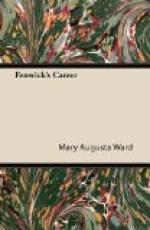HUSBAND AND WIFE
From an original drawing by Albert Sterner.
EUGENIE
From an original drawing by Albert Sterner.
PHOEBE’S RIVAL
From an original drawing by Albert Sterner.
‘Be my messenger’
From an original drawing by Albert Sterner.
ROBIN GHYLL COTTAGE
A nearer view of Miss Ward’s cottage. (See frontispiece.)
FENWICK STOOD LOOKING AT THE CANVAS
From an original drawing by Albert Sterner.
All of the illustrations in this volume are photogravures, and except where otherwise stated, are from photographs taken especially for this edition.
INTRODUCTION
Fenwick’s career was in the first instance suggested by some incidents in the life of the painter George Romney. Romney, as is well known, married a Kendal girl in his early youth, and left her behind him in the North, while he went to seek training and fortune in London. There he fell under other influences, and finally under the fascinations of Lady Hamilton, and it was not till years later that he returned to Westmoreland and his deserted wife to die.
The story attracted me because it was a Westmoreland story, and implied, in part at least, that setting of fell and stream, wherein, whether in the flesh or in the spirit, I am always a willing wanderer. But in the end it really gave me nothing but a bare situation into which I had breathed a wholly new meaning. For in Eugenie de Pastourelles, who is Phoebe’s unconscious rival, I tried to embody, not the sensuous intoxicating power of an Emma Hamilton, but those more exquisite and spiritual influences which many women have exercised over some of the strongest and most virile of men. Fenwick indeed possesses the painter’s susceptibility to beauty. Beauty comes to him and beguiles him, but it is a beauty akin to that of Michel Angelo’s ’Muse and dominant Lady, spirit-wed’—which yet, for all its purity, is not, as Fenwick’s case shows, without its tragic effects in the world.
On looking through my notes, I find that this was not my first idea. The distracting intervening woman was to have been of a commoner type, intellectual indeed rather than sensuous, but yet of the predatory type and class, which delights in the capture of man. When I began to write the first scene in which Eugenie was to appear, she was still nebulous and uncertain. Then she did appear—suddenly!—as though the mists parted. It was not the woman I had been expecting and preparing for. But I saw her quite distinctly; she imposed herself; and thenceforward I had nothing to do but to draw her.




